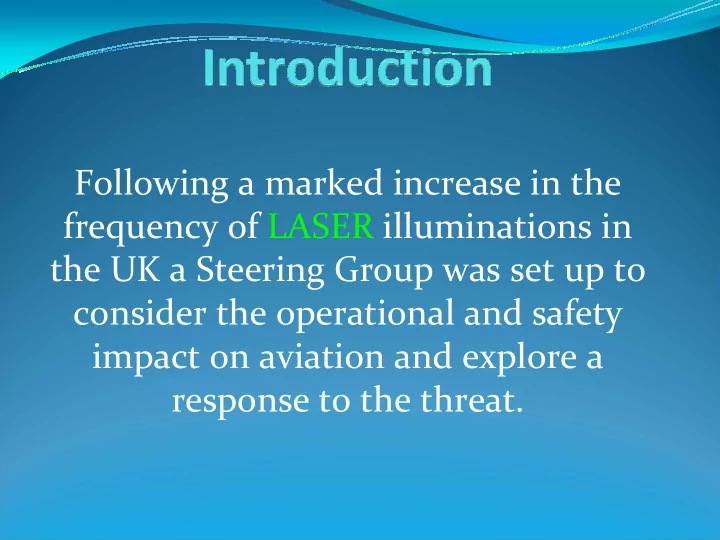

Following a marked increase in the frequency of LASER illuminations in the UK a Steering Group was set up to consider the operational and safety impact on aviation and explore a response to the threat.
The Steering Group Home Office Police NATS CAA: SRG Medical Flight Ops Regulation Enforcement Today’s presentation forms part of their response
The Laser Threat L ight A mplification by S timulated E mission of R adiation
What is the Threat? The greatest threat to the safety of an aircraft from a LASER source is its ability to impair the vision of the crew and distract them from their duties at a critical stage of flight
Who Presents the Threat? So far, in the UK, the perpetrators who have been apprehended have largely been individuals with no intent to cause the endangerment or destruction of an aircraft They have little or no comprehension of the possible consequences of their actions
LASER Induced Ocular Effects Glare/Dazzle After Image Small Retinal Injury Haemorrhage
LASER Induced Ocular Effects Glare/Dazzle Scattered LASER light obscures the image Disappears when LASER stops Exacerbated by dirty or wet windscreens etc Much more severe at night Any ‘night vision’ adaptation will be degraded
LASER Induced Ocular Effects After Image Caused by saturation of retinal photoreceptors Persist from 1 sec to several minutes after LASER stops, then recovers Recovery dependant upon brightness of exposure to LASER Severity of effect varies between individuals
LASER Induced Ocular Effects Small Retinal Injury Permanent loss of a few photoreceptors in the retina Visual effect usually still negligible
LASER Induced Ocular Effects Haemorrhage Large area of retina impaired/destroyed Can severely impair vision
What is the Effect on Vision ? Scattering and reflection inside the eye/sensor spreads LASER light across the image and obscures the scene behind it A LASER is sufficiently bright that weakly scattered or reflected components can easily be brighter than the scene that you are trying to see.
Some Good News (from the Men in White Coats) The hazards associated with the LASER threat, currently experienced by aviation are typically temporary, and of a glare/dazzle/after image level There is little or no hazard of retinal injury, at aircraft operating height & range, in relation to the current threat
Threat Response It was agreed by the Steering Group that a response to the threat was required covering in following key areas: Education Tactics Training Reporting
Threat Response ‐ Education Reduce the impact of LASERs on operations by increasing the awareness of the threat within aviation Re ‐ enforce the fact that permanent damage to vision does not likely exist from current threat Educate the public that LASERs are not toys and pose serious danger to aircraft
News reports, aimed at the public, have been produced and broadcast on TV, Local Radio and the Internet by the BBC & GMTV You are now receiving an Information & Education presentation made for use by commercial aviation
Threat Response ‐ Tactics Consider the impact of a LASER strike on the cockpit Develop cockpit drills (SOP’s) to negate, as much as possible, the effects of any LASER strike
Tactics developed by Police Air Support Units have helped to negate/minimise the effects of any LASER illumination on themselves Commercial Operators should develop their own response to the threat
Threat Response ‐ Training Consider introducing the experience of LASER dazzle as part of training ‐ range or simulator based Test developed cockpit SOP’s as part of routine simulator or line training
Police crews are much more aware of the threat from LASER illumination and practice evasion, detection and location of source locations. All Police crews will, at minimum, be exposed to LASER illumination through video presentation
Threat Response ‐ Reporting Report any LASER attack or activity to ATC as soon as possible Include (if possible) location, height, geographical location of LASER source or direction/distance from aircraft, duration & type of attack (deliberate or searching), colour, pulsed (flashing) or continuous Follow up the ATC report with an MOR
All Police Air Support Units are establishing clear lines of communication with their local ATC to ensure a timely passage of information concerning any LASER activity. Once in place we aim to be made aware of an incident within 2 minutes.
Why Bother Reporting? Nothing Ever Gets Done Each report provides information that helps paint an accurate intelligence led picture of the problem From that picture, national and local strategies can be put in place to prevent or deter attacks and where possible, detect and prosecute offenders Without a victim there is no crime!
What Does the Future Hold? Work is being carried out looking at aids to defence such as visors, filters and glasses A new offence is being written for submission outlawing the shining of a LASER or bright light at an aircraft A national co ‐ ordination of Police response to LASER attacks is in place in conjunction with the CAA & NATS
Conclusion The threat poses a danger to the safe operation of aircraft but little, or no threat of permanent retinal damage exists from the lasers currently in use Tactics developed by Police Air Support Units to negate the effects of an attack are allowing for the increased apprehension and prosecution of offenders The effort to counter the threat is now being co ‐ ordinated at National level between the Police, CAA & NATS
Recommend
More recommend